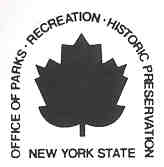| The Officers Club |
| |
| at Fort Niagara State Park |
|
|
Executive Summary
Report on the Murals in the Officers Club
Fort Niagara State Park
Youngstown, New York
On July 1, Dr. Sally Webster, Professor of American Art at Lehman College and the Graduate Center of CUNY, examined the four murals in the Officers Club at the request of State Parks. Staff of the Niagara Frontier Park Region gave Dr Webster a tour of Fort Niagara and the neighboring area as part of her orientation. Dr' Webster has written and lectured extensively and has a special interest in Public Art. Dr. Webster was retained by State Parks to comment on the artistic and historic, significance of the four murals. Dr. Webster was provided a variety of background information prior to her visit, including David Dickinson's recent report "The Officer's Club Building", Joyce Zucker's conservation assessment, and a videotape of Winthrop Aldrich's recent interview with Ernst Wille.
Dr.Webster includes a brief history of Fort Niagara and a general description of each mural in her report. The following are excerpts from Dr Webster's report.- There is no question that the murals should be preserved - - cleaned, restored and maintained for the future. While none of the artists is well known nor are the murals themselves of great aesthetic merit, the artists have distinctive backgrounds and the murals historic importance is undeniable . . .
the murals do not illustrate arbitrary subjects but are related directly to the site in the largest sense. Specifically, the Officers Club was a building designed to accommodate the dining and social activities of the officers of the 28th Infantry Regiment. As such three of the murals, Crawford's in the Ballroom, Dyczkowski's in the Officers Mess and Johnson's in the Grill Room, all relate to the history of this distinguished military regiment . . . The fourth mural, by German artist Ernst Wille, is unique and a highly personal addition to the building and, it is safe to say, was not intended as part of the club's original design . . . the building's decorative. program is remarkably cohesive, a unity that is not immediately apparent . . .
the most noteworthy, and most successful, aesthetically speaking (of the three murals done by American. artists) is Crawford's Cantigny . . . the composition is striking and is well-designed for its gabled space . . . Crawford effectively recaptures the violent conflict between the opposing armies . . .
On the Basement level . . . Dyczkowski painted his multipaneled mural, Defending Forts . . . what in fact is depicted is the history of weaponry from the middle ages to 1940 . . . the panels read like a continuous scroll in which soldiers in landscape settings display and use historic weaponry . . .
(in the Grill Room on the other side of the basement) Johnson painted the series The U S at War. The title, however, is far too general, for what in fact is represented are the active duty stations of the 28th Regiment . . . the elements Loftin (Johnson) includes in his mural are not unexpected - - infantry in combat, soldiers at parade rest, an officer in open car, horses and wagons entering a town after battle . . .
these three sets of murals . . . are all of a piece, that is, their connection to the Officers Club and the history of the 28th Regiment is clear. Crawford shows us an actual battle, Dyczkowski illustrates the history of armaments and their use by the infantry over time including the 28th Regiment, and Loftin (Johnson) represents a larger narrative of the 28th Regiment's importance militarily during the first three decades of the 20th century . . .
the most intriguing of the building's murals, Ernst Wille's American History . . . there is a subtle irony in Crawford's depiction of an incident from World War I in which the Americans defeated the Germans, facing a mural by the World War II German soldier Ernst Wille, a POW interned at Fort Niagara . . . as for the mural, it speaks first of all to Wille's European training. The composition with its piling up of forms in a tiered arrangement recalls the flat, triangular compositions of medieval church frescoes. His figures are more fully developed and modeled as compared with the more illustrational style of the Americans. Yet his painting also refers to Fort Niagara . . . the thread which connects the various figures are the construction and activities associated with the Fort over time . . . by using characters found in its (U.S.) history (Wille) created an intriguing tribute to his American captors . . .
| OFFICERS CLUB SITE MAP |
| FORT NIAGARA STATE PARK | OLD FORT NIAGARA |
| Info-Poland a clearinghouse of information about Poland, Polish Universities, Polish Studies, etc. |
